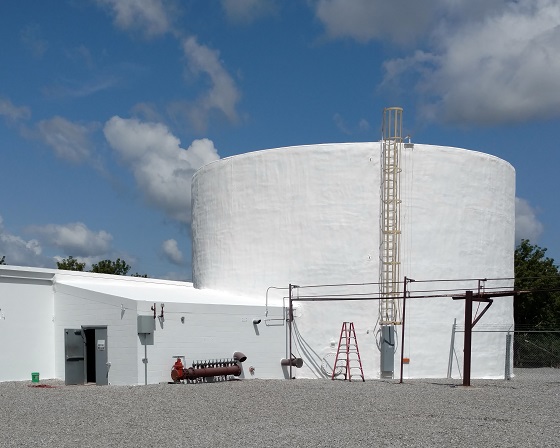It’s not every day that a contractor can say they worked on a project that they’d initially coated some 30 years before. That’s exactly what happened to Denny Vandewater, owner of Sadler Coating Systems out of Eagle Grove, Iowa, and past president of the Spray Polyurethane Foam Association (SPFA). In 1989, only a few years after he joined the contracting company, he and his crew at the time applied 3 inches (7.6 cm) of closed-cell spray polyurethane foam (SPF) and an elastomeric protective coating to a 7,500-square-foot (696.8 m²) steel tank.
“We’re in the northern climate — we’re in Iowa — and we have some severe weather in the wintertime,” Vandewater explained. “And since the tank does have water, it was to keep the water from freezing. For their own insurance purposes, they have to have enough water supply on site that had they had a fire in this processing plant they have a water source to put it out.” The 45-foot-tall (13.7 m) tank, which holds 500,000 gallons (~1.9 million L) of water for fire suppression, is owned by Ag Processing. It's located at the company’s soybean oil extraction plant about 65 miles (104.6 km) from Sadler headquarters in Mason City.
Flash forward 30 years. According to Vandewater, although the system was in fair condition, especially considering its age, there was some damage to the coated system around the bottom of the tank due to impacts from snow removal equipment. It was time to bring the tank’s system to the 21st century. Over the years, he kept in contact with the ever-changing project managers of the facility and was sure to let them know more recently that the system was well past its recoat window. That’s “basically what got my foot back in the door,” he said. The current project manager heard him and was on board for the update.
Top to Bottom
At 45-feet (13.7 m) high, the tank required that Sadler’s current crew (two to three members, depending on the task) use JLG lifts to access the higher surfaces, mainly during power washing and coating since most of the SPF damage was done near the ground level. “Course, because it’s an industrial client, we had to have all our safety gear on — harnesses, hard hats, the whole works — plus go through a safety orientation, which is pretty much standard in all of these plants anymore,” Vandewater explained. They were also sure to wear their Miller harnesses when working from heights.
 Also, the tank is located near a highway, which meant the crew waited until less windy days to apply the SPF, also called spray foam. They had any cars from the nearby parking lot moved on those days, too.
Also, the tank is located near a highway, which meant the crew waited until less windy days to apply the SPF, also called spray foam. They had any cars from the nearby parking lot moved on those days, too.
Being in close proximity to the roads did bring one positive aspect to the coordination, though: the crew was able to mobilize their equipment right up to the tank. That’s not always the case on an industrial project. “Everything
—
all of our equipment
—
we were able to pull up in close proximity to the tank. There were really no obstacles,” Vandewater said. That meant that, along with their standard gear of Alkota 3,000 psi (20.7 MPa) power washers, a Graco H40 foam proportioner, and a Graco Premier King pump, they only needed a couple hundred feet of hoses to reach the top.
“We tackle the higher part first and then work our way down, make sure that everything’s covered,” Vandewater said. Power washing was first. Then came the spot repairs with the spray foam. Two crew members, wearing identical protective gear, applied up to 3 inches (7.6 cm) of Accella’s Premiseal 2.8 lb. (1.3 kg) spray foam.
The final layer was the coating, following the masking of an access ladder, a few hatches, and any other components that they wanted to protect from overspray. The coating was Rapid Roof III, an acrylic elastomeric from Conklin, chosen because it is Class A fire-rated and has to be able to protect the SPF from hail and other weather events. It was applied in two layers to achieve a total average of 32 mils (812.8 microns).
Solid Support
The positive working relationship between Vandewater and the client came in handy when it was time to circle the tank via the lift. “There was one side of the tank that it was harder to access because it was kinda wet and soft, and the plant had brought in some heavy ballast rock and put it around for us so we could maneuver the lift around the tank,” Vandewater said. According to him, the client was “good enough to do that.” The alternative could have been a muddy mess.
Back to the Future
After 30+ years in the business, Vandewater plans to retire in September 2019. His wife’s father started the umbrella business called Sadler Construction in 1953, and Vandewater is planning on keeping the coatings part of the company in the family by passing the reins on to his nephew, Scott Sadler, an SPFA Professional Certification Program (PCP) Master Installer. His name fits the bill, after all! For now, after about five days on the job, the crew was ready to clean up, pack up, and move out…’til 2049!
